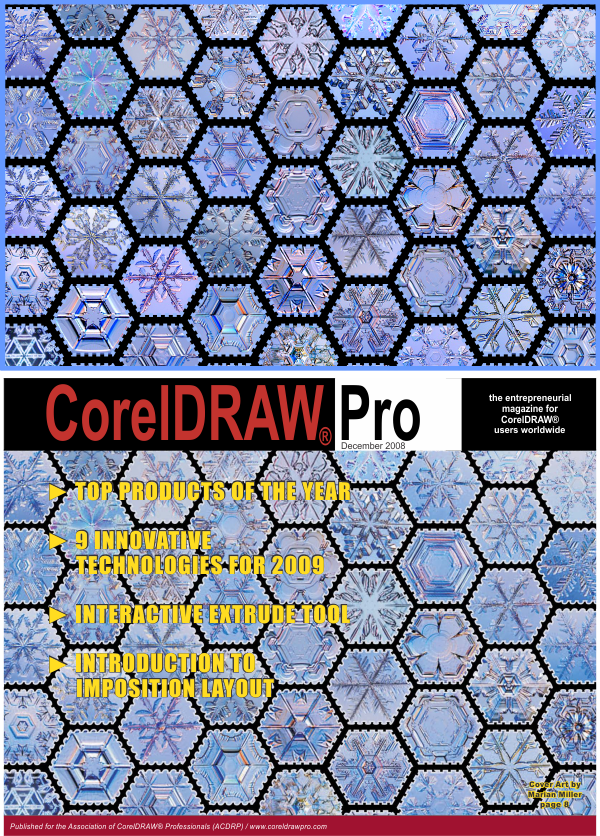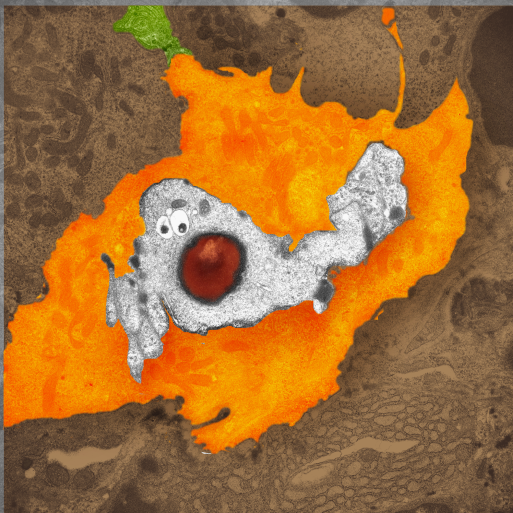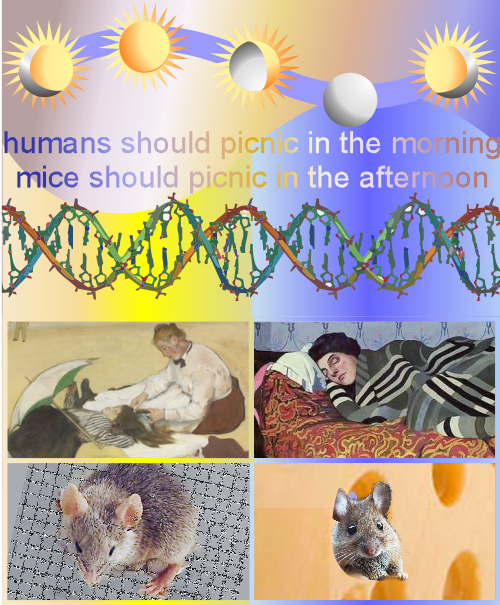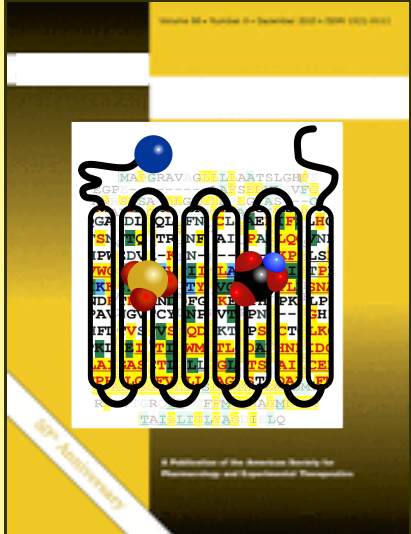All these snowflakes used in a diagram (interlaced hexagons) were taken by a professor at Cal Tech. I contacted him for permission to use his “real” images. No monetary gain for me was derived, but I thoroughly enjoyed using the variety that nature has to offer and that he captured on camera and posted online. Also thanks to Mike Neer who is editor of this CorelDRAW help magazine, as he let me play around with images for a few of the covers.
Monthly Archives: September 2018
Click 5 – aka casper the friendly ghost
One fun image from long ago, never a cover illustration, but could have been one at some point, particularly for a fall issue of a throw-away-journal. This is actually from a micrograph taken from a KO mouse CLICK5. The particulars of that particular KO mouse have long passed from my memory, but constructing the image is still fresh. ha ha..
White part is the parietal cell nucleus, nose is red nucleolus) cytoplasm is pumpkin orange, and the green stem is a portion of of another cell.
Skin cancer clock – illustration for cover
Not all illustrations make it to the journal covers. Going back half a dozen years I found this illustration (requested by Aziz Sankar) about biological clocks, UV exposure and cancer. My illustration did not make it onto the cover of proposed journal (at this point I cannot even remember which journal it was submitted to) but when I saw it i thought… what a cute attempt. So here it is anyway.
Off-center N terminals of SP-D fuzzyballs
 There is nothing I am doing here but questioning the current notion of how surfactant protein D is arranged into fuzzyballs. I have none of my own images to present, just those published by others which count is close to 75, from several authors.
There is nothing I am doing here but questioning the current notion of how surfactant protein D is arranged into fuzzyballs. I have none of my own images to present, just those published by others which count is close to 75, from several authors.
The publication of Arroyo et al that I have mentioned many times has very lovely AFM micrographs, and they have provided counts of 600+ SP-D images, and it is from these the few of these they published that I am making suggestions that perhaps the N terminals of surfactant protein D molecules are NOT dead center, but arranged in a sort of “ring” near the center instead. The other suggestion is that the arms of the surfactant protein D hexamers (maybe dodecamers) are not straight rods, as almost universally depicted in diagrams of SP-D, but rather are gently curved, almost as if they are hexamers whose interaction at the center is tangent to a center sphere, but at an angle of 60-100 degrees. In measuring the angles in just this one fuzzyball, the average degree was about 67o. (lower left is measured from the dotted lines in upper left — nb, this was just one fuzzyball, and there are many ways to draw those arcs than the way I drew them the first time.)
Image on the left (with its dotted lines) is almost identical to the one posted before (here) but i changed the bending of some of the dotted lines to what I thought was a better fit. In addition I added two more images, with different contrast, and outlined in blue the areas where the N terminal portions of the hexamers make a tangential connection with each other. I think that this (and other fuzzyballs I have observed) pretty much show up as multiples of 2 which is what might be hexamers. Of those which I have currently measured, there will be an angle between SP-D arms, but I will also measure them again, thinking of the molecule itself as an entity which is made up of slightly curved hexamers (or possibly dodecamers), and the angles will certainly be different.
One thing that makes the N terminal attachments NOT being dead center is the presence of slightly brighter areas near the N terminals, which could be representative of the glycosylation sites. For small bright areas to show up at a distance which is proportionate to the ring-center, is encouraging.
Lower right figure has a single hexamer (bent) in which i have measured the angle, and also outlined the bright areas of the N terminal(s), and possibly the glycosylation site(s).
I am impressed by the fact that the CRDs are “lumpy” in this particular image, and I have traced around them, there are almost suggestive of the three CRD domains of the trimer.
One thing that is easy to question on this post is why i drew the arcs with a convex curve and why the sample of a hexamer looks like the curves are concave..haha good question.
N Glycosylation site on SP-D
There is a little discrepancy here, likely due to the dearth of protein modeling for the complete protein of surfactant protein D. In any case, you can see from the picture of Arroyo et al, (top) and a diagram (middle from a commonly reproduced diagram available on the internet) which has N glycosylation site in a different relative position, and Arroyo’s diagram again lower middle which might come close but is not exactly where the bright spot is on the AMF image, and the bottom image, also from a google search which doesn’t bother to show an N glycosylation site. Dotted line lines up where this “might” be in parallel diagrams. You can see there is lots of variation. So to be more precise in this i should have overlapped the N terminals in the second figure down. and checked to see if in fact the branch indicated actually was intended to be a glycosylation site. (not so LOL). I will try to edit this later.
Cover submission – protein – aa – molecule
Surfactant protein D – fuzzyballs
Arroyo et al have published what I think is a great paper using atomic force microscopy to look at many different multimers of surfactant protein D. There are a couple of things that I think they saw that might be what I also noticed looking at so many images of SP-D with various EM methods.
That is, there seems to be a blip or bulge in the SP-D structure close to the N terminal, and I marked that with some images in a previous post, then removed them for a summary page and the early video clip of SP-D. I think they are real, and also this publication indicates that it is the N glycosylation site…. and used some experimental manipulations to justify that view. Another issue is that the N-terminal sites of SP-D dont really often line up into a single area, they look sometimes like they are groups of separate arcs which have an angle of about 40 degrees (as measured on the micrograph below (the small angles) two angles were about 120 degrees. The center doesn’t look like a concentric area, rather a radially spaced loop-association.
This micrograph is from Arroyo et al, and it shows (as do many other images from their publication) what I am trying to indicate. Actually many of their fuzzyball micrographs show this the inner segmented ring rather than a single central density. I used their picture, and photoshopped it to eliminate background notations and debris, and other nearby molecules (you can see these in their original picture so you can compare) but I did not change the image of the molecule in any way. SO: one of the big issues is the curviness to the arms of the SP-D molecule (see my blue line in the image below), and another is the-off-center radially arranged N-terminal densities. These just make it unlikely that there is a “center” point where the N terminals come together in a single lump space. A third issue is that it seems like the angles between the hexamers (if in fact that is how they assemble into fuzzyballs… one hexamer at a time, or perhaps one dodecamer at a time, where the the angle is not that “acute” but is pretty broad, maybe on the order of 40 degrees. This is what the dodecamer shows most typically so there may be a reason to assume that in the fuzzyball that the 40 degree angle for the four arms (and a broader angle of 140 degrees between arms) is maintained. Blue ring (that I have added to image below) might be where other interactions in the fuzzyball structure bring the structure together in a sphere? or disc? at points of intersections of the “loops”. Other loops and centers around the blue ring are shown with white dotted lines. This particular fuzzyball one would prefer to see with even numbers of arms (they may be there)…. but apparently an arm or a couple of them got misplaced in the preparation process (LOL)… it is also my suspicion that there is a quantity “four” – that is, that the elements are divided into quadrants as reasonably convincingly shown in the micrograph below, and that works out to the 16 arms (an even number and multiple of 4) which pervades the surfactant protein D images that I have collected so far. White bar is 60nm according to Arroyo et al’s original image. Blue circle is about 40nm relative to their white bar marker.
Lichen planus
– wish there was more help for those with this condition. my best to all who suffer with it.
Strive vs strife
STRIVE: toil try fight struggle quarrel contend
STRIFE: fight battle conflict quarrel dispute
I wondered if these words were related, yes, in fact from the same root — in middle europe listed at somewhere around 1200. It is interesting how the word strive has a positive spin, and the word strife has a negative spin. BOTH could mean conflict, perhaps the former is internal conflict and the latter is external conflict. just thinking out loud.
Are there angle restrictions on distribution of SP-D trimers in fuzzyballs
Looking through as many SP-D images as I could find in the literature I began to sense that the distribution (radial) of SP-D dimers was not random. I am determining the angle of separation of each arm of a SP-D fuzzyball to see if the numbers fall into classes of small, and larger. The data for these three pictures is spot-on. Various authors are responsible for these electron micrographs, i give them credit..they are not my personal photos. Images on the right and left are shadowed, image in the middle is AFM.
To create the round “generalizations” of angles in SP-D fuzzyballs, the actual angles were measured in the molecules below. A mean was obtained for each angle-set: e.g. the center pix had 4 measurements, as follows: I will measure all 90 images and see if the trend holds.
147.46
127.6
41.62
43.32







